NARBO
Report of the 1st High-Level Expert and
Leaders Panel on Water and Disasters (HELP)
-Current Discussion of ‘Mainstreasming Disaster Prevention’-
Tadashige Kawasaki / NARBO Secretariat
![]()
Background
1. UNSGAB and HLEP
Water is blessing from God and necessity of our life and economic activities. However, issues on ‘too much water’ and ‘too little water’ give us serious impact to our life. Due to rapid industrialization and urbanizations, ‘too dirty water’ has become one of the issues to be addressed immediately for securing our life and sustainable development. In addition, uncertainty to the negative impact of climate change also became one of the issues for us. To respond to the issues on water, the United Nations Secretary Generals Advisory Board on Water and Sanitation (UNSGAB) was established in 2004 by the United Nations Secretary-General (SG) to give advice as well as to galvanize action on water and sanitation issues. Responding to the recommendation by UNSGAB as articulated in Hashimoto Action Plan (HAP1), High Level Panel on Water and Disasters (HELP) was established in January, 2008 as an independent body to promote global actions to reduce risks of water-related disasters at various levels. UNSGAB endorsed the establishment of the Panel and acknowledged the Panel’s acronym as HLEP/UNSGAB. HLEP/UNSGAB announced the Action Plan in 2009 to promote actions by key partners and its own in order to fulfill the objective. The Action Plan is based on six principles of actions which are shared by UNSGAB and HLEP/UNSGAB.
2. Special Thematic Session on Water and Disasters and UNSGAB
The Great East Japan Earthquake (GEJE) occurred on March 11th, 2011, and the Tokyo Emergency Meeting was held in April, 2011 to discuss for the purpose of rising awareness of the necessity of urgent addressing issues on water and disasters among international community. As a result of the discussion, the meeting recommended UN to organize a special high-level session for dedicated discussion on water and disasters.
Responding to the call for action by HLEP/UNSGAB, the UN Secretary-General, Mr. Ban Ki-moon, organized the UN Special Thematic Session on Water and Disasters (Special Session) at UN Headquarters, New York, on March 6th, 2013. UNSGAB and HLEP/UNSGAB co-hosted the Special Session. Purpose of the Special Session is to affirm common understanding that “Water and Disasters” is one of the most important, pressing issues the international community should urgently address at the highest level.
3. Special Session and HELP
Taking the opportunity of the Special Session, HLEP/UNSGAB organized the New York Meeting on March 5th, 2013. The Panel members of HELP/UNSGAB decided to advance its agenda and agreed that HLEP should be strengthened through augmented high-level membership, particularly from governments, under the new name of by High-level Experts and Leaders Panel on Water and Disasters (HELP), which was agreed by the participants of the meeting.
Main purpose of HELP is to assist the UN, governments and stakeholders in mobilizing political will and resources, and galvanizing actions to raise awareness, ensure coordination and collaboration, establish common goals and targets, monitor progress, and take effective measures on water and disasters. The Mission of HELP includes i ; Raising global awareness on the issue of water and disasters, ii ) Galvanizing actions of the UN, governments, international organizations and stakeholders to enhance preparedness for water-related disasters at global, national and community levels, iii) Assisting governments and stakeholders in implementing recommendations of HLEP Action Plan, iv) Assisting international community to establish, monitor and achieve clear-cut targets on water and disasters in Post-2015 development agenda, v) Proposing a package of recommendations for governments and stakeholders to enabled short cut in creating a society prepared for water-related disasters and help realizing them, and vi) Providing with effective, concrete advice and input, voluntarily and upon request, to the global dialogue process and international implementing agencies on issues related to water and disasters.
Outline of the 1st Meeting
1st HELP meeting was organized by HELP, Ministry of Land, Infrastructure, Transport and Tourism (MLIT) of Japan, Japan International Cooperation Agency (JICA) with other support organizations, and was chaired by Dr. Han Seung-soo, the Founding Chair of HELP and the Former Prime Minister of the Republic of Korea. At the meeting, HELP was officially established, and intensive discussion for concrete actions of HELP was made among representative of national governments, international organizations, civil society and private sector. Day 1 was the field visit to the Tohoku region where affected the Tsunami caused by GEJE on 11 March, 2011 and saw the situation of recovery work for enhancing the discussion of HELP activities. Day 2 was the meeting for discussion, and the meeting was held at the Headquarters of MLIT on 4 June. Around 40 representatives of governments and experts jointed the 1st meeting. Please see attached program of the meeting.
HELP and NARBO
Network of Asian River Basin Organizations (NARBO) contributed to the Special Session by organizing the Side Event of the Special Session on 5 March, 2013. Discussions by the viewpoints of IWRM were made by experts, and we agreed the following points. Result of the discussion was reported to the Special Session on the following day.
[ 6 Points to be considered to address the issues on water and disasters by the viewpoint of IWRM] |
|
| There are issues on too much water, too little water and too dirty water in the world |
|
Coordination among different level of government organizations dealing water is necessary. |
|
Transition from top down approach to bottom up approach is needed to introduce participatory method about water governance. |
|
Cooperation and development tools are needed. |
|
| Investment to water is necessary | |
Role of infrastructure to minimize the negative impact and affect of extreme event is needed. In addition, best mix of combination of structural and non-structural methods is also needed. | |
In addition to the discussion, NARBO joined HELP/UNSGAB meeting on 5 March, 2013 and discussion for above mentioned discussion. As recognition of former useful and concrete activities on IWRM and contribution to the Special Session, Dr. Keizrul Bin Abudulah, Chairperson of Network of Asian River Basin Organizations (NARBO) was invited to the 1st HELP meeting as one of the official members. Mr. Tadashige Kawasaki, NARBO secretariat in Japan Water Agency (JWA) was working for the 1st HELP meeting as one of the secretariat team and reports the discussions of the meeting.
What we saw at Tsunami affected area.
On 3 June, 2013, majority of the participants of the 1st HELP meeting joined the field visit to the Tohoku region to see the situation of recovery work from Tsunami. At first, we visited Rikuzen-Takata city in Iwate Prefecture, and staff of the city explained the current situation. Unimaginable scale Tsunami caused by GEJE hit the city, and majority of central area of the city has been destroyed. Only some structures constructed by concrete have been remained. Around 1,900 people lost their life (Around 7% of the population of the city), and around 70 people are still missing. The city has catastrophic damage by Tsunami, and we were overwhelmed bythe scale of damage.
[Map of the Field Visit on 3 June, 2013] |
|
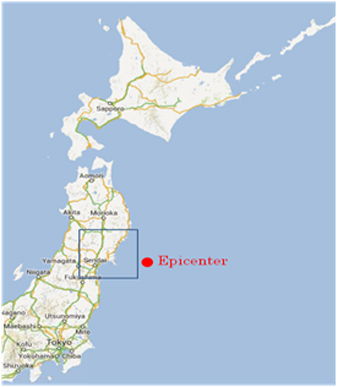 |
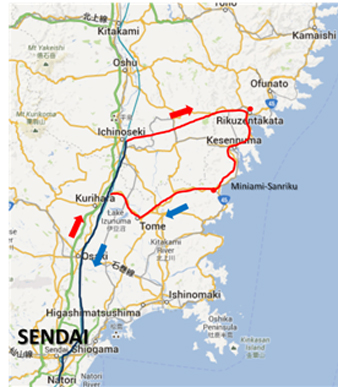 |
As recovery works, Rikuzen-Takata city decided to implement the Community Rebuilding Project. Land of former residential areas will be filled by 3 to 6 meter for new cities, and new residential area is now developing in the hill zone near former residential area. It takes couples of years to complete these constructions, and new urban policy is now discussing among residents and city government in Rikuzen-Takata city. Participatory approach for recovery works is now implementing.
[Central Rikuzen-Takata City –In front of the Rikuzen-Takata Station] |
|
Before GEJE
|
Taken on 3 June, 2013 |
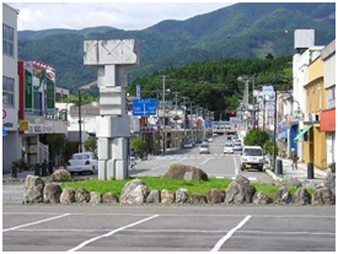 |
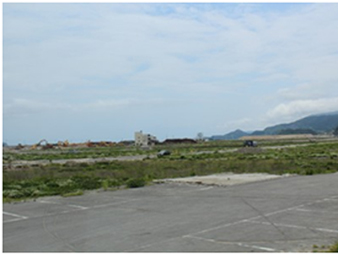 |
| Source; Rikuzentakata-Kamome-net |
|
We visited the coastal area of Rikuzen-Takata city. Before Tsunami, pine trees stretched as far as the eye can see, and there were around 70,000 pine trees at that time. Due to the unexpected scale of Tsunami, only one tree was survived. Hence, the pine tree is called ‘Miracle Pine Tree’. However, the pine tree died from chloride damage. City decided to leave the tree as a monument of recovery from Tsunami disaster by artificial treatment to the pine tree. When we visited, the preservation works had just completed, and we sew the restoration. According to the explanation, there was an argument about the restoration work among residents. Some people hopes to restrain the tree, and some people does not hope to do so, because they do not want to remember the painful experience. Cost of restoration works is covered by donation by not only the residents but also the supporter in the world.
[Photo of Field Visit in Rikuzen-Takata City] |
|
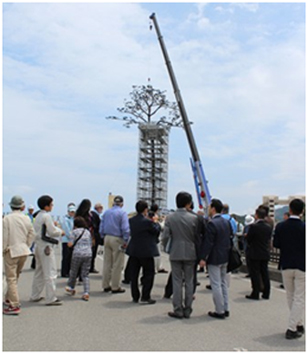 |
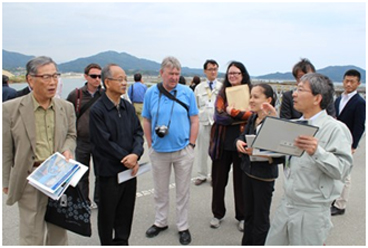 |
After Rikuzen-Takata city, we moved to Minami-Sanriku town in Miyagi Prefecture by seeing the affected areas and situations of recovery works. We visited the city hall of Minami-Sanriku town, Mr. Jin Sato, Mayer of the town welcomed us and explained the damage of Tsunami and situation of recovery work. According to the report of the worn, around 3,300 houses are affected, and it shares 61% of all houses in the town. 524 people died and 221 people are still missing, and it shares 4 % of total population in the town. Now town established the development plan of public housing for affected residents, and 970 houses will be constructed by the end of 2015 fiscal year. In addition, the town promotes collective relocation, and around 1,000 houses will move to higher ground area. The town has the building for disaster prevention in the central city, and its height is 12m. However, Tsunami destroyed this building, and now we can see only the framework of the building.
[Building for disaster prevention and current Minami-Sanriku town] |
|
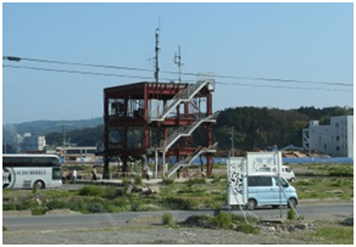 |
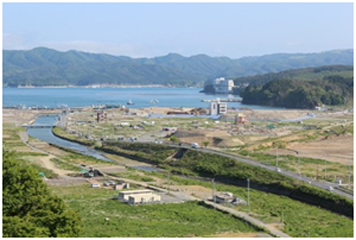 |
Regarding the budget of the town, budget of 2013 is 66.5 billion JPY (665 million USD), and it is approximately 9 times compared with the fiscal year in 2010. Mr. Sato told that this showed the strong will by central government to enhance recovery work. Minami-Sanriku town also lost many staff of government office, and support staff was dispatched from all over Japan and shares 30 % of the staff of government office now. Mr. Sato also told as a lesson learnt that Minami-Sanriku town had conducted the evacuation drill of Tsunami annually, however it is very difficult to keep the mind of disaster prevention in the mind of the residents.
Participants of the field visit learnt many lessons through the field visit and recognized that the necessity of the best mix of nonstructural and structural measures for disaster prevention and strong will of central government. Having in our mind, participants joined the 1st meeting of HELP on 4 June, 2013 in Tokyo
Discussions at the 1st Meeting
The 1st meeting of HELP was held at the international conference room in the Headquarter of MLIT in Tokyo, and around 40 delegates of national government, international organization, private sector and experts on water and disasters joined. At first, Dr. Han Seung-soo, the Founding Chair of the HELP offered welcome remarks and told that the world need to respond to the issues on water and disasters immediately, and HELP needs to i ; follow-up the Special Session for getting the resolution of the UN General Assembly to make the member states focused on this issue continuously, ii ; create concrete target of disaster reduction at Post-MDGs and SDGs and iii ; advance HELP action plan.
As a representative of MLIT, Mr. Shigeru Kikukawa, Vice Minister for Engineering Affairs of MLIT welcomed the participants and stressed the necessity of making target of disaster reduction in Post-MDGs and establishment of mechanism of discussion and sharing information on water and disasters with UN member states and international organizations. Mr. Kikukawa also stressed that Japan is ready to contribute to these international efforts.
Mr. Akihiko Tanaka, President of JICA also stated as a co-host organization of the meeting and stressed that investment for disaster risk reduction should be enhanced to establish sound development and paid off in the near future. Dr. Yordan Uzunov, member of UNSGAB delivered the message of the acting chairperson of UNSGAB and stated that UNSGAB had unanimously agreed on the relationship between HELP and UNSGAB
H.E. Mr. Kittiratt Na Rang, Deputy Prime Minister and Minister of Finance, Kingdom of Thailand offered keynote lecture. He introduced the case study of Thailand flood in 1995 and 2011 as lessons learnt. According to his explanation, government of Thailand decided not to take any actions, although recommendations for investment to flood have been made by several institutions after the flood in 1995, and they had serious flood damage in 2011 more than what had been needed for investment. He stressed i ; necessity of understanding the nature of water and disasters, ii ; building capacity of community to support self-help measures, iii ; ensuring non-structural measures as a part of no-regret measures, and so on. He also stated that the importance of balancing between excessive and deficient and confirmed that Thailand is ready to cooperate.
[ Photo of the 1st HELP Meeting on 4 June ] |
|
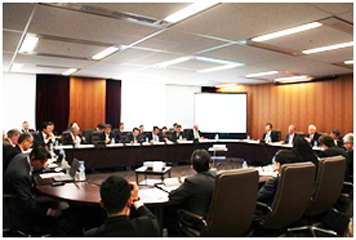 |
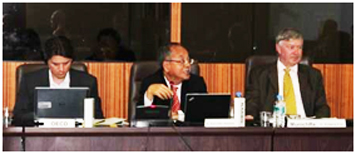 |
After the speeches, Mr. Kenzo Hiroki, Principal of ICHARM and Advisor of UNSGAB explained the history of UNSGAB and proposed strengthen of HELP into HELP and tentative actions of HELP. Following the discussion on it, Dr. Han confirmed the establishment of HELP, and HELP was officially established.
In the afternoon, intensive discussion about implementation of action by HELP was made. Members agreed actions should be implemented on i ; promoting regular discussion on water and disasters in the UN, ii ; Promoting Pst-2015 Target on Disaster Risk Reduction and iii ; .Advancing the agenda in HELP Action Plan. Dr. Keizul Bin Abdullah, Chairperson of NARBO told that Action Plan of HELP should put more emphasis on capacity building and creating leadership at all levels, and NARBO commits to contribute to HELP by filling the gaps at local levels. In addition, Dr, Abudullar made a question to H.E. Mr. Kittiratt Na Rang about what is the best way to persuade politician about disaster risk reduction, and Mr. Na Rang answered that activities of the Asia-Pacific Water Summit and HELP meeting would be useful for it, and I’m here to share the painful experiences and lessons learnt of flood in Thailand to other countries.
Way Forward
HELP meeting will be convened basically twice a year and operated by self financing. Secretariat of HELP will conduct surveillance to measure the progress of Hashimoto Action Plan II for making the concrete action plan of HELP.
Expectation to NARBO and NARBO’s Strategy
NARBO Chairperson is an official member of HELP, and Chairperson committed that NARBO contribute to HELP by connecting the needs and gaps of local levels. According to the Action Program 2013-2015 which was approved at the 5th General Meeting, NARBO has already committed to contribute to HELP, and related activities will be conducted as part of NARBO in the near future. In this way, NARBO is playing an important role of the discussion in the international level, and contribution from member organization by offering useful case studies on water and disasters is highly expected, and NARBO secretariat assist it continuously. In addition, NARBO secretariat shares the discussion at HELP and UN about water and disasters, Post-MDGs and Post-HFA with NARBO members.